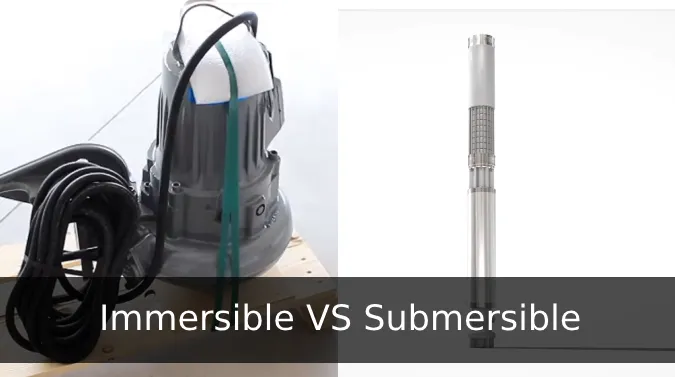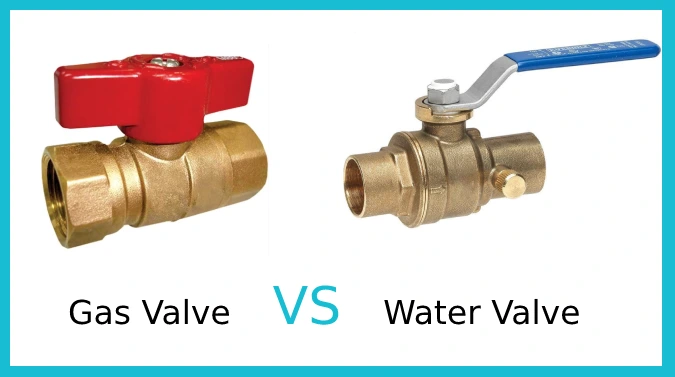Last Updated on July 16, 2023
In terms of pumping systems, submersible and immersible pumps are commonly used types. While both types are used for liquid handling, they have distinct differences in their design, construction, and functionality.
Understanding these differences is crucial for selecting the appropriate pump for specific requirements.
Immersible pumps are mounted vertically with the motor positioned above the liquid level, while submersible pumps are fully submerged with the motor included. Pump enclosures or sumps are required for immersion pumps, whereas submersible pumps are self-contained.
Let’s examine the differences between immersible and submersible pumps in greater detail.
Immersible vs Submersible: What’s the Difference?

You should be aware of some key differences between immersible and submersible systems. We discuss the differences in these categories.
- 1. Design and Installation
- 2. Construction Materials
- 3. Motor Protection and Cooling
- 4. Motor Features
- 5. Cost and Maintenance
Let’s discuss the differences in more detail.
1. Design and Installation
The design and installation of immersible and submersible pumps differ significantly, primarily in terms of their positioning, housing, and installation requirements.
Immersible pumps are designed to be vertically mounted with the motor above the liquid. They typically require a separate pump enclosure or sump to house the motor.
The pump end of an immersible pump is extended below the liquid level, allowing it to draw in the liquid for pumping. This design allows for easy access to the motor for maintenance and repair purposes.
Immersible pumps are commonly used in applications where the liquid being handled is corrosive or aggressive, requiring the motor to be situated in a separate enclosure for protection.
In contrast, submersible pumps are designed to be fully submerged in the liquid they are pumping. The motor is included as an integral part of the pump and is designed to operate underwater. Submersible pumps work at different depths within liquid, depending on the specific application requirements.
They are commonly used for sewage and water handling, including groundwater extraction, well water pumping, and wastewater treatment.
The self-contained design of submersible pumps eliminates the need for a separate motor enclosure or sump.
2. Construction Materials
Submersible pumps are typically made with materials that are compatible with water, such as stainless steel, cast iron, or thermoplastics like PVC.
These materials are chosen because they can withstand the harsh environment of being submerged in water for extended periods.
Stainless steel is a popular choice due to its corrosion-resistant properties, while cast iron is often used for its durability and affordability. Thermoplastics like PVC are also commonly used for their resistance to chemicals and abrasion.
On the other hand, immersible pumps offer a wider range of material options, including stainless steel, engineered plastics like polypropylene and PVDF, and even exotic materials for highly corrosive environments.
These materials are chosen based on the specific needs of the application and the type of fluid being pumped. For example, PVDF is a popular choice for highly corrosive fluids, while polypropylene is often used for its resistance to acids and alkalis.
Exotic materials like titanium and Hastelloy may also be used for extreme environments where other materials would quickly corrode.
3. Motor Protection and Cooling
To ensure your motor stays cool and protected, you need to consider how to keep it from overheating and getting damaged, like a shield protecting a warrior from enemy attacks.
Regarding motor protection and cooling, there are significant differences between submersible and immersible motors.
For submersible motors, the liquid surrounding them provides direct contact with the motor housing, which serves as a cooling system.
To ensure proper cooling, the motor must be fully submerged, with the liquid level always above the motor housing.
The liquid also acts as a barrier between the motor and any contaminants in the effluent, preventing damage to the motor.
However, submersible motors require regular maintenance to ensure the cooling system remains functional and to prevent the buildup of debris that could impede the motor’s performance.
On the other hand, immersible motors are designed to operate in a dry environment but can withstand occasional flooding.
They use Totally Enclosed Fan Cooled (TEFC) or Totally Enclosed Blower Cooled (TEBC) enclosures and feature a sealing system to ensure reliable operation underwater.
This means that immersible motors require less maintenance than submersible motors, but they may not be suitable for all applications.
In situations where the motor must be fully submerged, submersible motors are the better choice.
4. Motor Features
When considering motor options, it’s important to take into account the specific features that each type offers.
Submersible motors, for instance, are designed to prevent water ingress through machined fits with O-rings and an oil-filled chamber with a mechanical seal.
These motors also have moisture probes that detect any moisture entering the motor. These features make submersible motors ideal for applications where the motor will be fully submerged in water, such as in deep wells or in wastewater treatment plants.
On the other hand, immersible motors typically have a dual oil seal configuration and an explosion-proof style conduit box.
These motors are designed to be partially submerged in water, and they may also offer additional features like thermostats and motor space heaters for specific environmental requirements.
It’s perfect for sump pumps and water treatment tanks, where only a portion of the motor is submerged in water.
5. Cost and Maintenance

If you’re looking for a more economical option with less maintenance, you might consider the type of pump that is simpler in construction.
Immersible pumps are generally more cost-effective than submersible pumps due to their basic design and placement of the motor.
The motor of an immersible pump is positioned above the water level and is easily accessible for any necessary repairs or maintenance. This reduces the cost of maintenance and repair, making it a more budget-friendly option.
However, submersible pumps are popular because of their ruggedness. They’re designed to be fully submerged and protected from external elements, making them corrosion-resistant.
This makes them a great option for areas with harsh environmental conditions where a pump may be exposed to corrosive substances.
Submersible pumps also require less maintenance due to their design and the fact that they’re fully submerged in water. This reduces the frequency of repairs and the associated cost, making it a more durable option in the long run.
Immersible vs Submersible Comparison Chart at a Glance:
| Aspect | Immersible Pumps | Submersible Pumps |
| Design and Installation | A vertical mount with the motor above the liquid | Fully submerged with the motor included |
| Require a separate pump enclosure or sump to house the motor | Self-contained units | |
| Pump end extended below the liquid level | Can be placed at various depths within the liquid | |
| Common Applications | Handling corrosive and aggressive liquids like chemicals, acids, or abrasives | Water and sewage handling applications including groundwater extraction, well water pumping, wastewater treatment |
| Construction Materials | Stainless steel, engineered plastics (polypropylene, PVDF), and exotic materials for corrosive liquids | Stainless steel, cast iron, thermoplastics (PVC) |
| Motor Protection and Cooling | Operate in a dry environment with enclosures for reliable operation under water | Rely on surrounding liquid for cooling |
| Motor Features | Dual oil seal configuration, explosion-proof conduit box | Machined fits with O-rings, oil-filled chamber with a mechanical seal, moisture probes |
| Cost and Maintenance | Generally more cost-effective due to simpler construction and motor placement | Higher initial costs but known for durability, ruggedness, and resistance to corrosion |
| May require additional maintenance due to exposure to external elements | Require less maintenance as they are protected from external elements |
When would you use a submersible pump?
A submersible pump is an ideal choice when faced with scenarios requiring water extraction or flooding situations.
This type of pump is designed to be fully submerged in water during operation, making it highly effective in removing large volumes of water in areas such as flooded basements, boats, and low-lying regions with excessive water accumulation.
Additionally, submersible pumps are more energy-efficient than traditional pumps since they rely on hydraulic power rather than relying on additional energy sources. Invest in a submersible pump for an affordable, effective, and long-term solution for water extraction needs.
How long can you run a submersible water pump?
A submersible water pump can be run continuously for as long as needed, as long as there is a consistent water source available.
These pumps are designed for extended usage and are equipped to handle prolonged operations without issues.
However, it is important to ensure that the pump is not run dry, as this can cause damage to the motor and other components.
To avoid potential overheating and malfunctions, submersible pumps require a sufficient water supply for cooling. Therefore, it is crucial to monitor the water level and ensure that the pump always has an adequate amount of water to operate.
How far below the water level should a submersible pump be?

The recommended distance to position a submersible pump below the water level is around 10 to 20 feet, depending on factors such as well depth and water quality.
This placement ensures that the pump is not located directly at the bottom of the well, where sediment and debris tend to accumulate, potentially clogging the pump and reducing its lifespan.
By elevating the pump, you can also minimize the risk of exposure to potential contaminants, further extending the pump’s lifespan. However, it’s important to note that the exact distance may vary depending on the specific recommendations provided by the manufacturer.
Additionally, other factors such as the type of pump, the purpose of the pump, and the flow rate requirements may also impact the optimal placement.
Choose the Right Pump for Your Needs – Immersible or Submersible
Submersible and immersion pumps have distinct differences in their design, construction materials, motor protection, and cooling mechanisms.
Immersible pumps require a separate enclosure for the motor and are suitable for corrosive environments, while submersible pumps are self-contained and commonly used for water and sewage handling.
Submersible pumps are known for their durability and resistance to corrosion, requiring less maintenance. They can run continuously as long as there is an adequate water supply, but care should be taken to avoid running them dry.
When installing a submersible pump, it is generally recommended to position it a certain distance above the well bottom to prevent clogging.
Ultimately, the choice between immersible and submersible pumps depends on your specific needs and the nature of your application.
Considering factors such as the liquid being pumped, environmental conditions, and manufacturer guidelines will help you make an informed decision.



